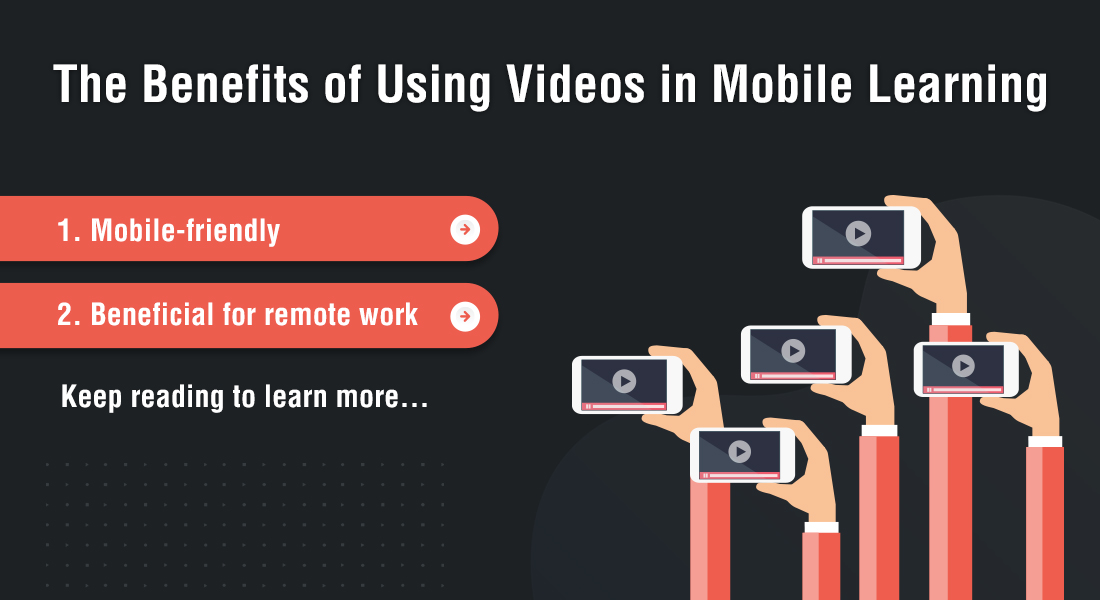Creating Mobile-based Learning Solutions with Videos and Gamification

Mobile devices are integrated into business and learning today. In response to its ubiquitous usage among the modern generation of learners, organizations are beginning to work on better solutions for ‘on-the-go’ learners. Learning for these learners must not be offered merely in terms of accessibility, but also should involve some elements of fun and engagement. Because of their adaptability and appeal with modern learners, videos and gamification, have a prominent role to play in learning.
This blog highlights the importance of creating mobile-based learning solutions incorporating videos and gamification as main strategies.
Videos:
Video is a highly preferred media for learning for modern learners. Why? Because they prefer to access their information in the short video format. They prefer watching moving images and listening to someone speak.
1. Videos on Mobile: Information When They Need It
Most sales people and service technicians are incessantly on the move, and as a result, have little to no time to turn up for classroom training sessions. Videos of the product information can be easily accessed on the learners’ tablets and smartphones, or they can be made available online for 24X7 access through a Learning Management System. These videos are an ideal way of imparting just-in-time (JIT) product knowledge support to employees when they need it.
2. Videos for Assessments/Knowledge Checks
The perfunctory multiple-choice tests in most online learning modules can be easily defeated by video assessments. Knowledge checks require learners to recall, analyze, and synthesize the information they gathered from the course. For this task, videos show employees going wrong while operating a piece of machinery (Safety training), giving a sales pitch (Sales training), breaking a company rule (Compliance training), failing to identify sexual harassment (Prevention of Sexual Harassment training) and so on. These video-based assessments can be accessed on their mobile (via LMS or a native app), which they can take on-the-go.
Videos as such, disguised under assessments, allow the learner to identify the mistake the employee in the video is committing. These assessments not only let them evaluate their learning but also make the reinforcing and practical applicability of the learning possible in an effective manner.
3. Videos for Performance Support
To reiterate what I mentioned earlier, just-in-time (JIT) product information goes a long way in enhancing the performance levels of learners. Many organizations are using mobile-compatible tools in conjunction with an LMS to provide the required information about their products to service technicians at the point of need. They are directly supporting the technician handle the task at hand and get through the difficulties they might face at work.
Take the example of a service technician who is investigating the faulty engine of a tractor and identifies that there is a problem with the fuel injection system. He opens his mobile and watches the video containing the steps of a procedure to repair the faulty system.
Gamification:
Using game elements and mechanics for online learning you can offer learning content that learners can not only easily identify with but also makes it a fun learning experience for them. This is the most crucial advantage that gamification brings to the table – it cuts through the monotony of learning.
1. Gamification for Making Learning Social
At times, learning may not happen in isolation. Learners may want to learn in groups – from their peers and colleagues. Integrating gamification elements in modern mobile-friendly social collaboration platforms such as a Learning Management System (LMS) can genuinely motivate your employees and foster a healthy competition. In fact, this study proposes that learning with gamification increases learner disposition to experience flow than a non-gamified learning experience.
For example, a learner looking at the gamified leaderboards on their mobile-friendly LMS displaying the name of active participants and the badges they have earned for completing certain tasks might just be encouraged to push themselves towards better productivity.
2. Gamification for Periodic Reinforcements
Gamified mobile learning solutions can also include short, interactive games such as puzzles, word of the day, which on completion can reveal small bite-sized concepts. Learners do not have to spend hours to achieve these learning objectives. These reward-based short bursts of gamified mobile modules will ensure that the learner receives instant feedback to reinforce the training objectives in a gradual manner.
3. Gamification for Making Assessments Stress-free
Instead of asking your candidates to complete an assessment that feels like a test, they get to play a series of game-based assessments. The frustration of slogging through hour-long assessments can be easily avoided by using gamified assessments which test a learner’s skills by making them participate in interactive and highly engaging scenarios.
4. Gamification for Additional Reading
Based on how the learners perform in the game-based mobile learning module, you can offer small snippets of information. In other words, learners need to earn the right to unlock and access the materials. Your game can also have levels. As learners unlock each level, new snippets of learning content can be revealed making the whole learning experience fascinating.
5. Gamification for Smooth Onboarding
More often than not, an onboarding process is more about discovery and learning. Use gamification combined with mobile learning to improving the new employee onboarding process. Allow them to discover and learn. For example, a new employee has no idea about the different departments in the organization. Create a virtual gamified environment of the complete organization with all departments. The learners can use their mobile to explore and receive information by visiting each department to build up their knowledge of the organization.
This novel concept of combining videos, gamification and mobile learning strategies is being used by many organizations to realize different types of modern learning goals. With the ubiquity of mobile, the engagement factor of videos and gamification it is not surprising to understand that organizations are able to offer a three-fold benefit to the learner in terms of accessibility, engagement and fun.





